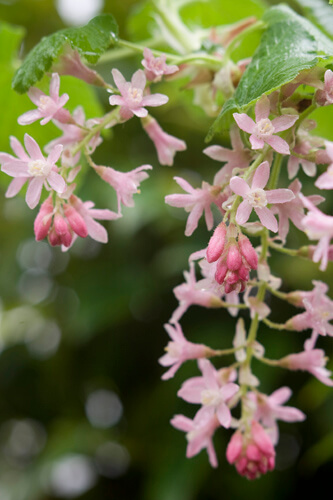
Help nature in your yard by planting native plants. They improve water quality and provide food for birds, wildlife and pollinators. ©Richie Steffen, Great Plant Picks.
Would you like to improve your yard’s contribution to helping birds, wildlife, pollinators and the planet in 2023? Here are a few steps you could take to help nature in your yard in 2023.
Plant native plants and flowers
“Native plants improve water quality, provide habitat, reduce streambank erosion and can improve property values,” according to Snohomish County. Native plants attract pollinators such as native bees, honey bees, butterflies, moths and hummingbirds. Make sure to choose plants that bloom at different times of year so pollinators and birds have food throughout the season.
Here are some resources to help you choose the right native plants for your landscape.
- King County Native Plant Guide provides a database of common native trees, shrubs and ground covers.
- The Washington Native Plant Society has a great list of resources for birds, bees and wildlife.
- Here is a pollinator-friendly native plant list for western Washington from the Xerces Society for Invertebrate Conservation.
- Hansen’s Northwest Native Plant database has lists by category: ferns, perennials, shrubs, trees and wetlands.
- One of our blog posts has links to lists of plants for pollinators.
Plant a tree
Help nature by planting a tree. Trees help keep us and the planet healthy. They have numerous benefits. Trees:
- Help keep the air and water clean
- Remove and store carbon to combat climate change
- Provide shelter and shade
- Encourage wildlife
- Improve our mental and physical health
- Provide food
- Increase the value of homes and businesses
Here are tips on how to select, plant and care for trees.
Feed your soil
A diverse web of life in your soil feeds your plants and keeps the landscape healthy. Healthy soil can store carbon, reducing your landscape’s impact on climate change. According to The Garden Continuum, “In the average residential yard, rebuilding and increasing organic matter in the top 12 inches of topsoil by just 1% could remove one ton or more of carbon from the atmosphere.”
Add organic debris such as compost, grass clippings and organic mulch to your landscape beds. Soil-dwelling organisms will break it down, improving soil texture and making nutrients available to your plants. Healthy plants are more resistant to pests and diseases.
We can help you build healthy soil in your landscape. Our natural lawn, tree and shrub care services use compost tea, mycorrhizae (beneficial fungi), micronutrients and organic fertilizers to build and maintain soil health.
Downsize your lawn
A lawn may be an attractive addition to your landscape, but it is a monoculture that doesn’t provide habitat for bees, birds and wildlife. Help our native bees and other critters by downsizing your lawn.
A Bee Friendly Lawn is the right size for the way you live and use your landscape. It has lawn in areas where you use and enjoy it, but doesn’t have grass in areas where it is hard to grow or maintain, such as shady areas, steep slopes, shorelines and little-used areas. You will reduce the amount of time and energy you spend maintaining your landscape, while helping nature.
You could replace the lawn with trees and shrubs. You could add a vegetable garden, ground covers, mulch or a new space for outdoor living. You could convert part of your lawn to native plants.
Find more about growing a Bee Friendly Lawn on our website. Find out more about habitat restoration from the Xerces Society.
Provide shelter and habitat for pollinators
Pollinators are critical for flowers and for much of the food we eat. You can help pollinators by providing access to shelter and habitat. Native bees use cavities in dead wood, hollow stems, or brush piles to lay eggs and grow into adults. Butterflies may need specific plants for food and shelter.
All pollinators need high-quality habitat that provides an abundance of flowers, shelter and nesting sites, and protection from pesticides. Here are some tips from the Xerces Society on providing nesting habitat for bees and butterflies.
An easy way to provide shelter is to keep some plant debris when you clean up your yard. Dried seed pods, stems and ornamental grasses provide homes for beneficial insects and food for birds. Here are some fall cleanup do’s and don’ts.
Reduce your carbon footprint by 5%
According to the Xerces Society, “Climate change is a threat to the environment and all the creatures that live on earth. Calculate your carbon footprint and make adjustments to lessen it by the end of the year.”
There are many ways to reduce your carbon footprint. Some ideas: drive less, fly less, buy less, find alternative transportation, eat fewer animal products, adjust your thermostat, insulate your home, switch to renewables, buy energy-efficient appliances, use less water, reduce, reuse, recycle and more.
It is easy to find ideas and tips for reducing your carbon footprint on the web. Commit to some concrete actions that work within your life and budget. Every step you take makes a difference.
